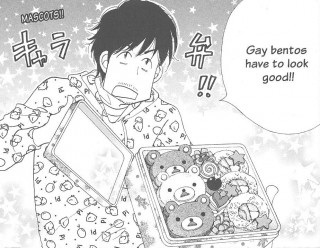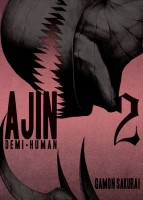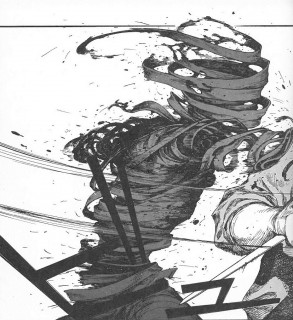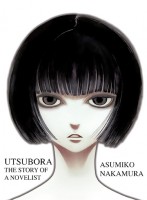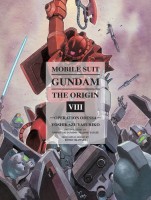 Creator: Yoshikazu Yasuhiko
Creator: Yoshikazu Yasuhiko
Original story: Yoshiyuki Tomino and Hajime Yatate
U.S. publisher: Vertical
ISBN: 9781939130686
Released: December 2014
Original release: 2011
Although I was vaguely familiar with Gundam before reading Yoshikazu Yasuhiko’s Mobile Suit Gundam: The Origin, the manga series was my first real introduction to the ever-expanding franchise. I was actually more interested in The Origin because it was created by Yasuhiko than for its Gundam connection, but I’ve been enjoying the series so much that I’ve started to look for other manga, novels, and anime set in the universe. Operation Odessa is the eighth volume in Vertical’s English-language release of The Origin. Published in 2015, the volume is based on the Japanese collectors’ edition released in 2011 and includes an essay by Makoto Yukimura in addition to a gallery of some of Yasuhiko’s color artwork for the series. The Origin is a reimagining of the original Mobile Suit Gundam anime from 1979. The last several volumes of The Origin have been an extended flashback not found in the original anime series, but with Operation Odessa the manga returns to the story’s current timeline.
After successfully defending itself from Zeon forces at Jaburo—though not without significant casualties—the Earth Federation has set out to reclaim more of the planet and its aligned space colonies. The key to its plans is the newly developed and highly advanced Gundam mobile suit which the ragtag crew of the White Base was somehow able to deliver to the Federation’s headquarters mostly intact. The Gundam prototype will serve as the basis for a mass-produced mobile suit that will hopefully be able to rival those developed by Zeon. Up until this point in the devastating conflict between the two factions, Zeon’s impressive technological achievements have given it a distinct advantage over the Federation. But now the tide of war seems to be changing. However, neither side will remain unscathed. The battles are still incredibly destructive and the loss of life continues to be immense. Even so, the end of the war may still not be coming anytime soon.
 The Origin began in space and has since moved Earthward, the space battles giving way to air and land battles. And now with Operation Odessa, sea battles have an important role to play in the conflict as well. With new arenas of warfare come new weapons, mobile suits, technology, equipment, and vehicles. It can actually be a little overwhelming at times, this sudden introduction of very specialized tools that don’t have much more explanation given beyond a name and a visual design. Inundated, readers are mostly left to glean the details of the differences in the capabilities and purposes of the individual units from their context within the manga. Much of Operation Odessa seems to be devoted to showing off these new toys of war in a way that is probably more meaningful to someone who is already well-versed in Gundam lore. Especially in the last half of the volume, the narrative tends to be jarring as it jumps from battle to battle, or from different points in the same battle, without much connecting material to smooth the transitions.
The Origin began in space and has since moved Earthward, the space battles giving way to air and land battles. And now with Operation Odessa, sea battles have an important role to play in the conflict as well. With new arenas of warfare come new weapons, mobile suits, technology, equipment, and vehicles. It can actually be a little overwhelming at times, this sudden introduction of very specialized tools that don’t have much more explanation given beyond a name and a visual design. Inundated, readers are mostly left to glean the details of the differences in the capabilities and purposes of the individual units from their context within the manga. Much of Operation Odessa seems to be devoted to showing off these new toys of war in a way that is probably more meaningful to someone who is already well-versed in Gundam lore. Especially in the last half of the volume, the narrative tends to be jarring as it jumps from battle to battle, or from different points in the same battle, without much connecting material to smooth the transitions.
While Operation Odessa could arguably be considered overly focused on equipment and technology, it is important to note that the manga still has a prominent human element to it, which is what makes The Origin such a compelling series. In particular, Kai, one of the young pilots connected to White Base, is heavily featured in Operation Odessa and develops significantly as a character. For the most part he has largely been a secondary character who provides a fair amount of comedic relief in the series. Except now he’s quite seriously fed up with all of the fighting and even tries to leave, only to find himself drawn back into battle and the tragedy of war. As Yasuhiko has shown repeatedly throughout The Origin, those who are directly involved in the conflict aren’t the only ones who are impacted by it. Civilians and non-combatants must also take action out of necessity, doing whatever they can to survive and protect those they love. It’s a lesson that Kai must learn the hard way in Operation Odessa if he is to understand his own role as a soldier.



